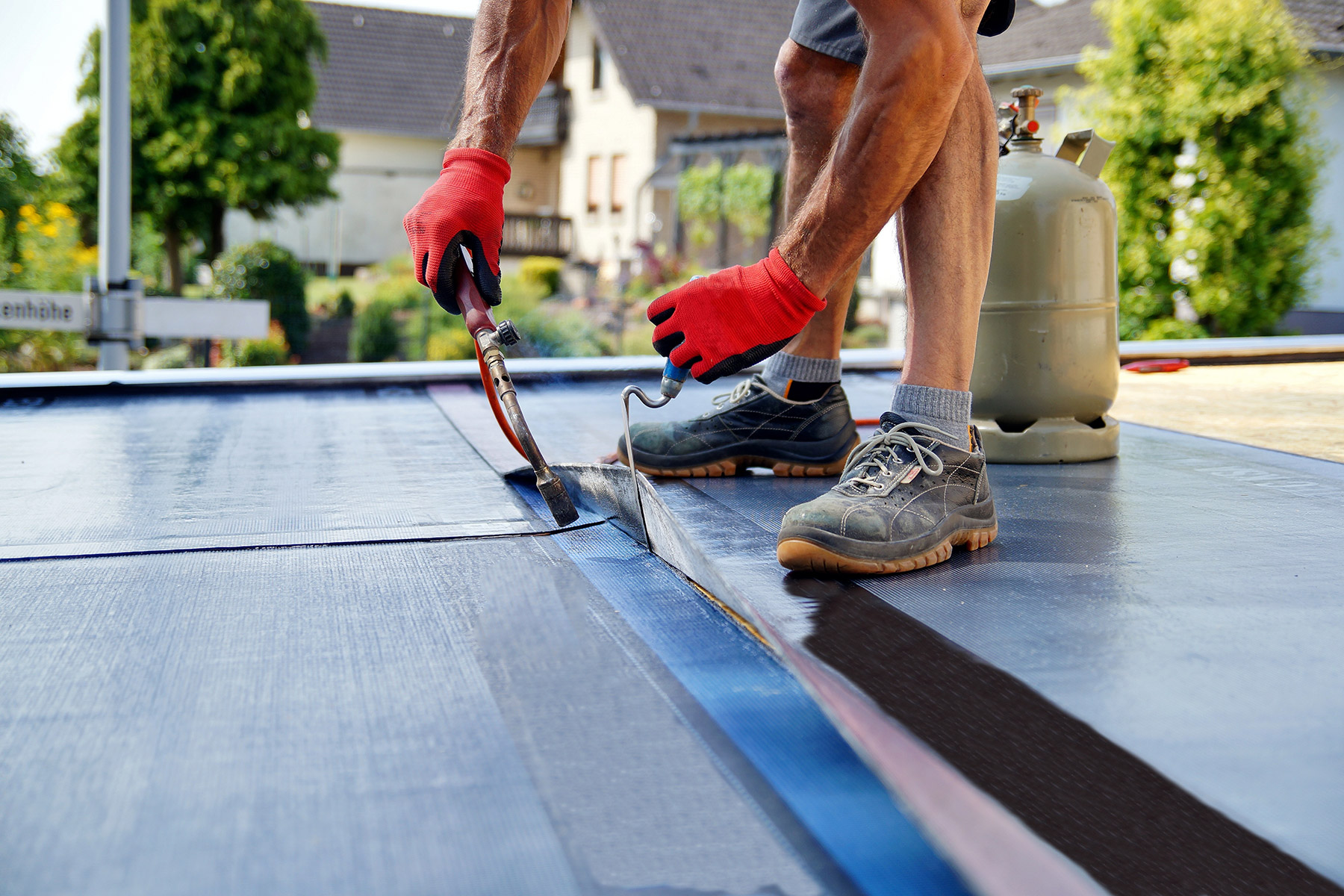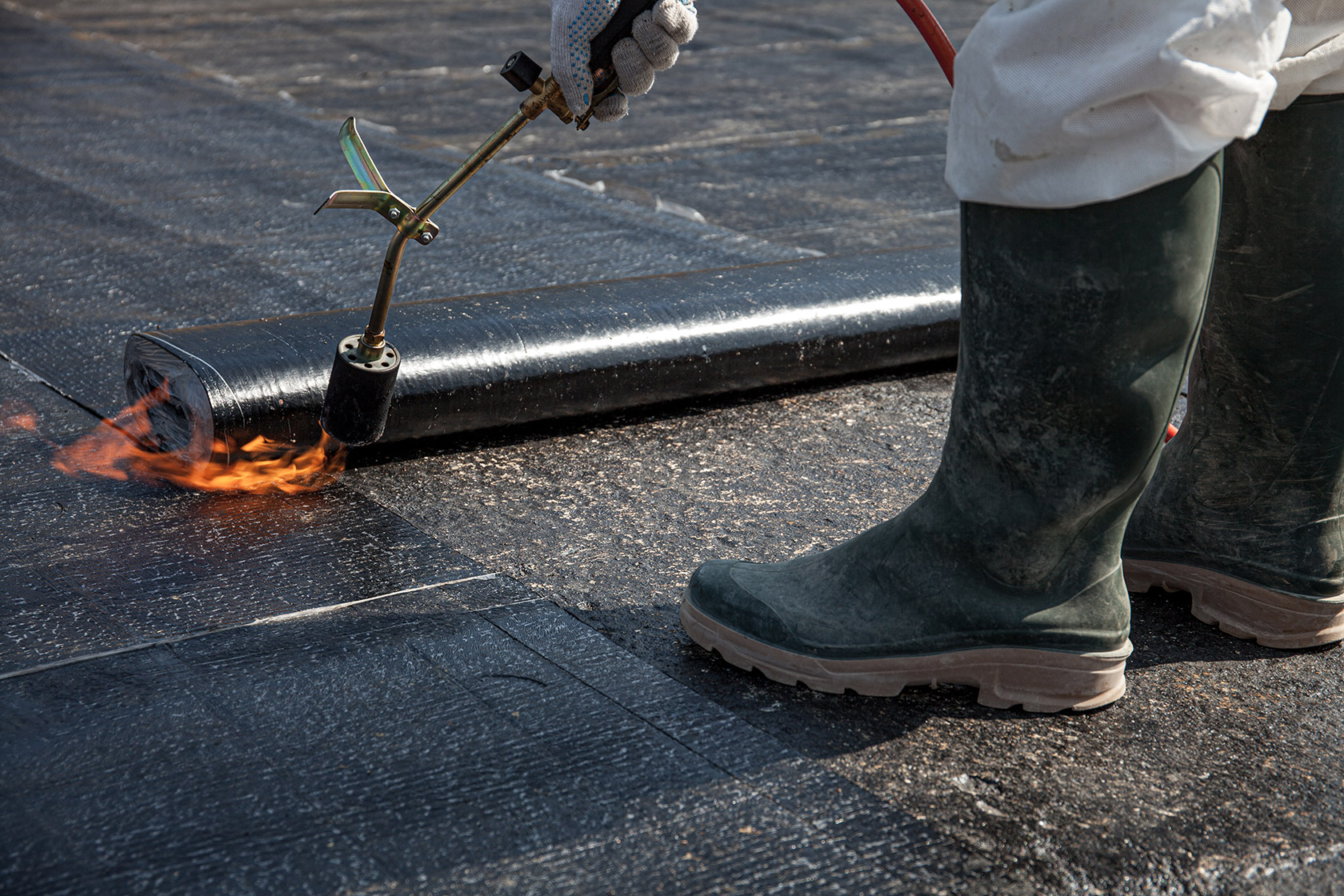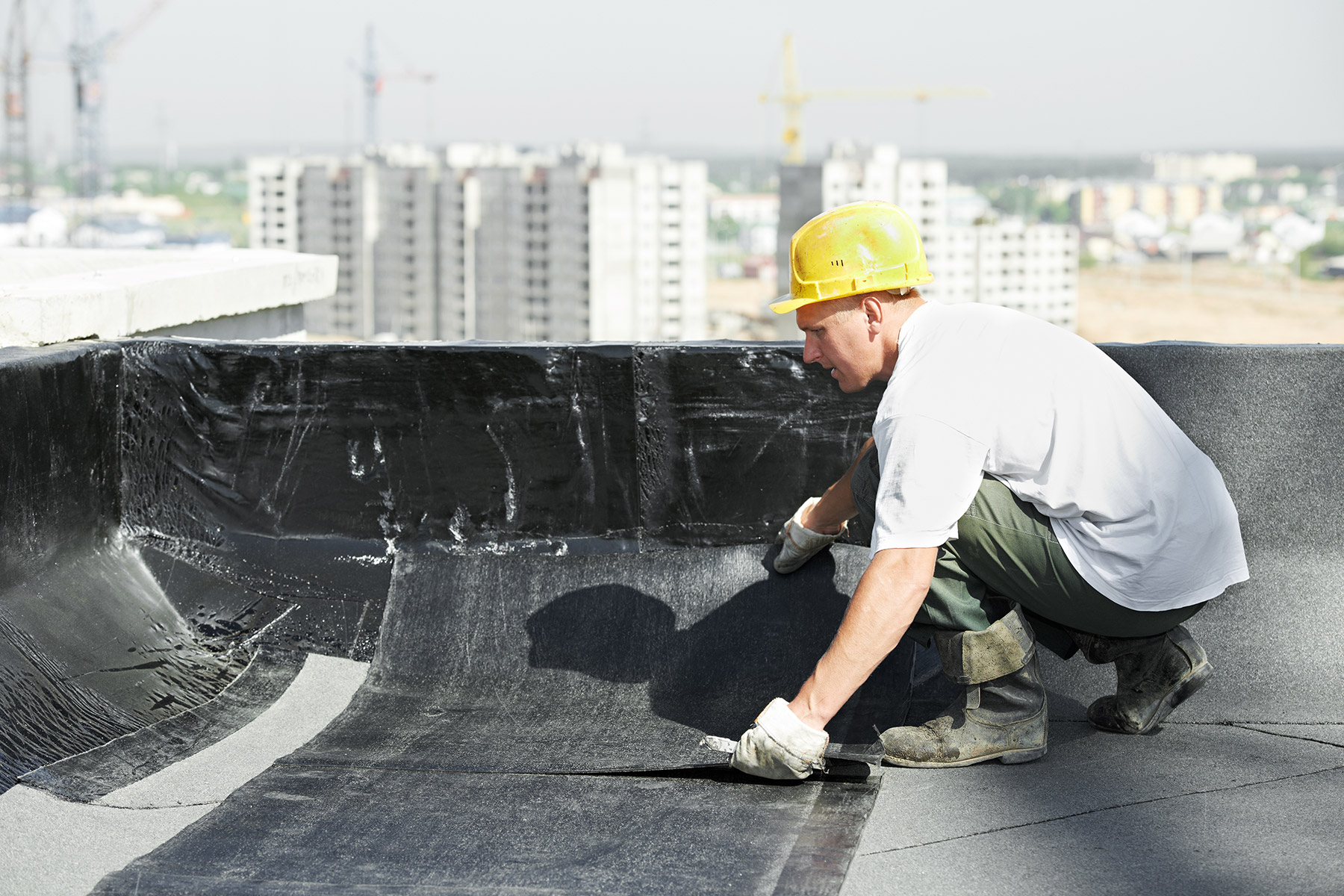Disclaimer: Please note that this article is intended to provide general information only, and is not a substitute for professional advice from a roofing contractor, architect or other specifier with respect to any particular roofing project.
A commercial roof tear-off is the process of removing an old flat roof (either the entire system or just the membrane) before the new one is installed. To give the new roof a fresh start, your roofers will tear off the old roofing materials down to the decking. Sometimes, even portions of the decking must be replaced during the tear-off.
Is a flat roof tear-off necessary? With single-ply membrane roofing systems, you might be able to leave the original roof on and place the new one on top. This is called a roof recover or a roof overlay. While roof overlays are a more common practice for asphalt shingles, they are still possible for commercial flat roof projects. But is a recover a good idea for your building? Below, we’ll explain why completing a commercial roof tear-off is strongly recommended and go over the advantages and disadvantages of the process.
- How Is a Flat Roof Tear-Off Done?
- What Is the Cost of a Roof Tear-Off?
- The Pros and Cons of a Complete Roof Tear-Off vs. a Roof Overlay
- When Should You Get a Tear-Off?
- FAQs on Roof Tear-Offs
How Is a Flat Roof Tear-Off Done?
A roof tear-off consists of removing the entire existing flat roofing system down to the decking and discarding its components. Roofers provide it exclusively as the first step in a new flat roof installation. You would not want a roofing team to rip off your old roof and leave it for a while before installing the new system, as your building would be vulnerable to the elements the whole time.
Roof removal is a labor-intensive process that takes considerable time. Sometimes, on particularly large roofs, roof tear-offs must be done in stages. If it takes too long to rip off the entire roof, the roofers may work in sections, installing new roofing materials on some spots before tearing off the old roofing on others. However, this process often complicates the project. Alternatively, roofers may install a temporary solution, like a tarp, as they pull the old flat roofing material off each section. This way, no sections are left exposed for too long.
Typically, the roofers remove all the old roofing at once, forcing them to work both quickly and safely. For old BUR roofing, roofers may use dry or wet vacuums to collect the ballast material. They may also use a dry or wet vacuum to remove any dirt, dust or debris that has gathered on a flat roof of any type. They may also make use of shovels, and other tools to pick up any loose material.
For modified bitumen as well as for single-ply membrane systems including TPO, EPDM and PVC, roofers typically use utility knives or saws to cut out manageable sections of the membrane. Heat guns, useful flat roof removal tools, may be used to soften the roofing membrane, especially around the seams, to make it easier to cut into or lift.
Regardless of the type of old roofing system that is being removed, roofers will eventually reach underlying layers, such as coverboards and insulation. For these layers, roofers will need to remove any fasteners that hold them down. They may also use roof scrapers or other prying tools to lift insulation quickly. When wet, insulation is heavy, so this can be a tough job.
All the old roofing material must be disposed of. Typically, the roofing company will arrange for a dumpster to be located just off the edge of the roof so they can easily drop discarded materials into it. If possible, they may arrange for the materials to be recycled. Otherwise, they are taken to disposal sites.
What Is the Cost of a Roof Tear-Off?
The cost of a roof tear-off ranges based on the work involved. BUR roofing and modified bitumen roofs are often more expensive to remove because they have many layers and are made of more material than other roofing systems. Therefore, the removal process is longer and costs the roofer more in labor, dumpster rentals and tool use. Single-ply membrane systems are less expensive to remove. While costs vary across regions, it is reasonable to estimate that the tear-off portion of your flat roof installation may cost $2 to $4 per square foot in USD.
However, you are unlikely to see the tear-off as a line item on your commercial roofing quote. Instead, roofing companies typically package the cost into the overall charge for labor. Figuring out what kind of discount you might be offered if you forgo the tear-off process is not as simple as just subtracting a line item or asking for a $2 to $4 per square foot reduction in cost.
If roofers forgo the tear-off process and decide to install a flat roof membrane directly on top of the old one (assuming they have found the building codes and the roofing system’s manufacturer allows them to do so), there is still substantial work to be done. The old roof surface needs to be prepared for the new roof, including cleaning off debris and removing the lightning protection system (so that it can be reattached). The design of the new roofing system may also need to be adjusted to work in these new circumstances. The roofer will need to take on additional costs, including consulting with an architect or engineer to determine if your building can handle the weight of both roofing systems.
Ultimately, if you are interested in skipping the tear-off process, you will have to negotiate with your roofer and see what kind of price reduction they would be willing to offer. You should also anticipate that some roofing companies may refuse to do this. There are good reasons to perform a roof tear-off, and some roofers will not want to provide a lesser-quality roof or help their clients deal with the issues that arise from flat roof overlays.
Why might a new roof overlay or recover not be as high-quality as a roof that was installed fresh on the decking? We’ll explain below.
The Pros and Cons of a Complete Roof Tear-Off vs. a Roof Overlay
When your roof is in good condition and relatively new, you might be tempted to get a roof recover instead of a full tear-off. It’s a simpler and more cost-effective way to make minor changes, like improving the roof’s aesthetics or increasing the roof’s solar reflectivity. Under the right circumstances, skipping your tear-off has benefits, including:
- Reduced costs: Your roofing company saves some time and money when they skip the overlay process, and they can pass these savings on to you. While a roof tear-off is not the bulk of the cost of a new flat roof, the savings could be significant. A $2 to $4 discount per square foot can add up quickly for commercial roofs of any significant size. However, it is important to weigh these short-term savings against the potential for higher future costs, which we discuss below.
- Reduced disruption: When you get a roof replacement on a commercial building, the work might be disruptive to business in the building and might present safety concerns even for those walking by. Skipping the tear-off stage means you might not have to place dumpsters next to the building, which would have otherwise disrupted foot traffic. It also means there is less risk of materials falling off the edge of the roof.
- Environmental benefit: The existing roof’s materials will remain on the roof instead of heading to a landfill. When your building gets its next new roof, all the old materials from the existing roof and the roof overlay will be removed. If you have new recycling options available at that point, which you do not have now, delaying the removal of the original roof may have been a more sustainable choice. Asphalt recycling is becoming more available in certain areas. A roof recover provides some benefits, but it is important not to overstate them. The cost reductions and convenience of skipping a roof tear-off this time are likely to be overshadowed by the cost and inconvenience of dealing with both roof layers when the building needs its next new roof. In fact, there are many cons of skipping the roof tear-off, including:
- Warranty issues: Manufacturers offer limited warranties on their flat roofing systems, but only when those systems are installed according to their instructions. Choosing to install a new roof on anything but decking could impact the warranty and reduce your coverage or entirely void it. Commercial roofers that normally offer their own warranties on labor may offer less or no coverage when installing an overlay.
- Insurance issues: Maintaining insurance for any large asset is important, including your flat roof. Insurance companies might offer low or no coverage in the event a problem develops with a roof overlay. This is especially true if the problem could have been discovered or prevented if the original roof had been removed.
- Compromised performance: The new recover may not offer the protection you’d like your roof to offer. An overlay may compromise the roof’s fire resistance, hail/impact resistance or wind uplift resistance.
- Moisture problems: Roofers must take care not to trap moisture in between various layers of the roof as they install it. The new roof may disrupt the proper ventilation of the old roof, or moisture may get trapped between the new roof and the old one. This can lead to serious issues with the roof, such as blistering of the new membrane.
- Structural problems: Buildings are designed to hold a specific load or weight. Roofing systems need to be carefully selected to ensure they do not exceed the safe load the building can handle. Roofers need to ensure your structure can even support two roofing systems before they install the second. Your choice of a roofing system may also be limited to keep under the structure’s weight limit. For example, green roof systems are typically too heavy to be layered at all.
- Reduced longevity: A roof membrane that is installed on top of an existing roof system may not last as long as a new roof system that is installed directly on the existing decking. Any issues with the underlying roof may be missed during installation and may impact the upper roof. In particular, moisture issues, minor leaks, and structural problems may all go undetected during the installation of the recover. They may impact the upper roof quickly.
Overall, completing a commercial roofing tear-off will allow you to get the full benefits of a new roof. You’ll have a higher-quality installation and more protection from potential issues from your manufacturer’s warranty, roofing contractor’s warranty and insurance company. Also, with proper flat roof installation, your roof is much more likely to have any underlying issues resolved. This means it should offer better protection to your building for a longer period.
Your options are also wider when you choose to start fresh with your new roof. When you tear off an old roof, you have the opportunity to install better insulation for superior energy efficiency. Or you can achieve better aesthetics with a new roof as, unlike an overlay, it is not installed on top of the irregularities of the old roof. In some circumstances, by removing the old roof, you may also be able to invest in newer roofing technologies. You may be able to choose systems that your roofers could not have installed as an overlay because they are too heavy or cannot work with the existing roof.
When Should You Get a Tear-Off?
If you consider getting a flat roof overlay instead of a complete tear-off, you should be aware that there are circumstances where this is not a wise decision. You should absolutely get a roof tear-off when:
- It is required by law: Building codes in your jurisdiction may not allow you to get a new roof without removing the existing roof. You should be aware of the relevant building codes in your own area and follow them.
- The existing roof is wet: If more than 30% of the existing roof is wet, then you should tear it off before installing the new roof.
In general, tearing off the existing roof before installing a new one is better for the long-term performance of the roof and offers other benefits and protections to the building.
FAQs on Roof Tear-Offs
How do you tear up a flat roof?
Flat roofing should be torn up in sections with tools, like utility knives, heat guns, saws, or dry/wet vacuums to help remove different kinds of materials. We recommend that only professionals with adequate training and safety equipment attempt to perform flat roof tear-offs.
What does tear-off mean in roofing?
In roofing, a tear-off is the process of removing the old roof. This is true in both residential and commercial roofing, with asphalt shingle roofs and flat roofing systems.
Can you replace part of a flat roof?
Yes, instead of doing a complete roof removal, there are many circumstances where you can just replace only the parts of the roof that are damaged. A roofing professional can advise you as to whether your roof needs to be completely replaced or if it can be repaired.
How much does it cost to have a roof torn off?
A commercial flat roof may cost $2 to $4 per square foot to tear off. This is only a reasonable estimate, and the precise cost of your tear-off will depend on the type of roof you need to be removed and other factors, such as the cost of labor in your area.
Can you overlay a flat roof?
There are situations where a new flat roof can be installed over an old one in what is called a flat roof overlay. However, there are many reasons not to do this, including protecting the overall quality and life span of the new roof. We discuss this in more detail above.
Is it OK to put a new roof over an old one?
In terms of commercial roofs with flat roof systems, it is sometimes acceptable to put a new roof directly over the old one. However, there are significant disadvantages to doing so, as we outline above.
How many layers can a flat roof have?
All flat roof systems, even single-ply membranes, have multiple layers because they include the main roofing material as well as insulation and flat roof underlayment. Some of these systems, such as BUR and modified bitumen, will have more layers than others. Your flat roof system should have exactly as many layers as called for in the building design specifications and as required by applicable building codes.
There are circumstances where you may have two flat roof systems on your roof. But you certainly do not want more than two.
How many times can you overlay a flat roof?
If your flat roof can have an overlay at all, according to your local building code and your manufacturer, it should have no more than one. Multiple overlays can lead to serious problems, including overloading the roof with too much weight or trapping moisture between different roof overlays and causing rot and roof failure.
Seek Professional Support for Your Roof Tear-Off
Flat roof contractors can help you understand more about whether you should get a whole roof tear-off or not as well as the cost and timeline of your roof tear-off and replacement. You can find commercial flat roof companies through IKO’s Contractor Locator.



